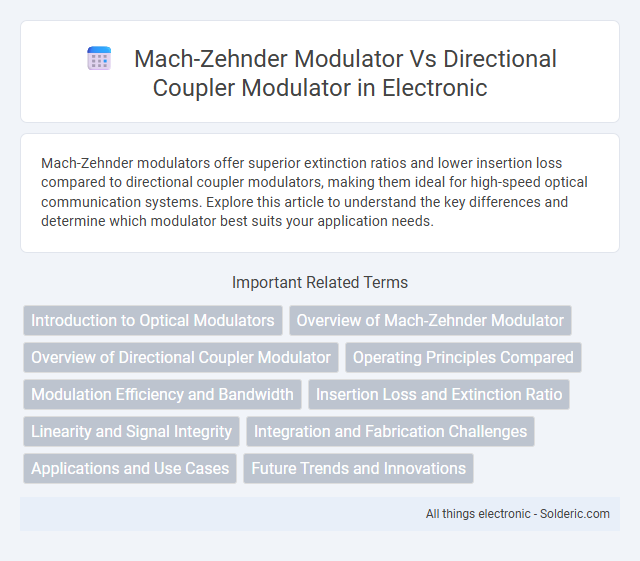Mach-Zehnder modulators offer superior extinction ratios and lower insertion loss compared to directional coupler modulators, making them ideal for high-speed optical communication systems. Explore this article to understand the key differences and determine which modulator best suits your application needs.
Comparison Table
| Feature | Mach-Zehnder Modulator (MZM) | Directional Coupler Modulator (DCM) |
|---|---|---|
| Operating Principle | Interference-based phase modulation using two arms | Coupling-based modulation via directional coupling of waveguides |
| Modulation Type | Phase and intensity modulation | Intensity modulation |
| Extinction Ratio | High (typ. > 20 dB) | Moderate (typ. 10-15 dB) |
| Insertion Loss | Low to moderate (around 3-5 dB) | Low (around 1-3 dB) |
| Bandwidth | High bandwidth (up to 40 GHz+) | Moderate bandwidth (up to 20 GHz) |
| Drive Voltage (Vp) | Moderate (usually 3-5 V) | Low (typically < 3 V) |
| Linearity | High linearity | Lower linearity |
| Size | Larger due to two arms | Compact |
| Applications | High-speed optical communication, coherent systems | Short reach links, simple intensity modulation |
Introduction to Optical Modulators
Optical modulators control light signals in fiber-optic communication by varying amplitude, phase, or polarization. Mach-Zehnder modulators offer precise phase modulation through interferometric structures, enabling high-speed data transmission with low insertion loss. Directional coupler modulators use evanescent wave coupling between waveguides for intensity modulation, providing compact size but typically lower bandwidth than Mach-Zehnder devices.
Overview of Mach-Zehnder Modulator
The Mach-Zehnder modulator (MZM) is an electro-optic device that controls light intensity by exploiting interference patterns within two separated optical paths. It offers high modulation bandwidth and low insertion loss, making it ideal for high-speed optical communication systems. Unlike directional coupler modulators, which rely on coupling effects between waveguides, the MZM provides precise phase control through differential phase shifts, resulting in superior signal quality and extinction ratio.
Overview of Directional Coupler Modulator
Directional coupler modulators utilize the principle of evanescent wave coupling between two closely spaced waveguides, enabling efficient modulation of optical signals through controlled power transfer. They offer compact size and lower drive voltages compared to Mach-Zehnder modulators, making them suitable for integrated photonic circuits. Your choice of a directional coupler modulator can enhance device performance by reducing insertion loss and improving modulation bandwidth in specific applications.
Operating Principles Compared
Mach-Zehnder modulators operate by splitting light into two arms where phase shifts induced by an electric field cause interference patterns modulating the output intensity. Directional coupler modulators rely on coupling strength changes between two waveguides to control the light transfer based on applied voltage, affecting the output power distribution. Compared to directional couplers, Mach-Zehnder modulators offer more precise phase control and typically provide higher extinction ratios in optical communication systems.
Modulation Efficiency and Bandwidth
Mach-Zehnder modulators offer superior modulation efficiency due to their interference-based design, enabling high extinction ratios and precise phase control, which translates to better signal quality in optical communications. Directional coupler modulators generally provide lower insertion loss but have limited bandwidth and reduced modulation efficiency compared to Mach-Zehnder devices. For applications demanding wide bandwidth and high modulation efficiency, your choice should lean towards Mach-Zehnder modulators to achieve optimal performance.
Insertion Loss and Extinction Ratio
Mach-Zehnder modulators typically exhibit lower insertion loss compared to directional coupler modulators due to their interferometric design that allows efficient phase modulation with minimal signal attenuation. Extinction ratio in Mach-Zehnder modulators is generally higher, providing better signal contrast and improved modulation depth, essential for high-performance optical communication systems. Your choice between these modulators should consider how the balance of lower insertion loss and higher extinction ratio meets the specific requirements of your optical network.
Linearity and Signal Integrity
Mach-Zehnder modulators exhibit superior linearity due to their balanced interferometric design, minimizing signal distortion and enabling high-quality analog signal transmission. Directional coupler modulators often introduce higher nonlinearities, which can degrade signal integrity and limit performance in precision applications. Your choice should prioritize Mach-Zehnder modulators when preserving signal fidelity and maintaining linear response is critical for system accuracy.
Integration and Fabrication Challenges
Mach-Zehnder modulators (MZMs) require precise phase control and balanced arms, making their integration on silicon photonics platforms more complex compared to directional coupler modulators, which rely on power transfer through evanescent coupling and are simpler to fabricate. The fabrication of MZMs demands stringent lithographic alignment and uniform waveguide dimensions to maintain modulation efficiency, while directional coupler modulators tolerate more geometric variation but may suffer from limited bandwidth and extinction ratio. Your choice depends on the trade-off between fabrication complexity and desired modulation performance in integrated photonic circuits.
Applications and Use Cases
Mach-Zehnder modulators are widely used in high-speed optical communication systems due to their excellent linearity and low insertion loss, making them ideal for data transmission in fiber-optic networks and coherent optical sensing. Directional coupler modulators find applications in integrated photonic circuits and analog signal processing where compact size and ease of integration with other components are critical. Both modulators serve key roles in telecommunications, with Mach-Zehnder being preferred for digital modulation formats and directional couplers favored for analog modulation and signal routing.
Future Trends and Innovations
Future trends in Mach-Zehnder modulators highlight advancements in ultra-high-speed modulation and integration with silicon photonics for scalable, low-power optical communication systems. Directional coupler modulators are evolving with innovations in material engineering, including the use of organic polymers and plasmonic structures to achieve enhanced modulation efficiency and miniaturization. Both modulator types are poised to benefit from emerging AI-driven design optimization and photonic integrated circuit platforms, driving next-generation performance in data centers and 5G/6G networks.
Mach-Zehnder modulator vs directional coupler modulator Infographic

 solderic.com
solderic.com